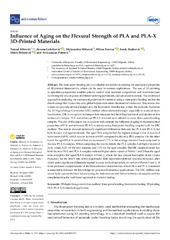| dc.description.abstract | The three-point bending test is a valuable method for evaluating the mechanical properties of 3D-printed biomaterials, which can be used in various applications. The use of 3D printing in specimen preparation enables precise control over material composition and microstructure, facilitating the investigation of different printing parameters and advanced materials. The traditional approach to analyzing the mechanical properties of a material using a three-point bending test has the disadvantage that it provides only global information about the material’s behavior. This means that it does not provide detailed insight into the local strain distribution within the material. However, the 2D Digital Image Correlation (DIC) method offers additional insight, especially in terms of strain localization. DIC is an optical technique that measures full-field displacements and strains on the surface of a sample. PLA and enhanced PLA-X material were utilized to create three-point bending samples. The aim of this paper was to analyze and compare the influence of aging on the mechanical properties of PLA and enhanced PLA-X materials using three-point bending coupled with the DIC method. The results showed statistically significant differences between the PLA and PLA-X, for both the new and aged materials. The aged PLA samples had the highest average value of maximal force around 68 N, which was an increase of 8.8% compared to the new PLA samples. On the other hand, the aged PLA-X material had an increase of 7.7% in the average maximal force compared to the new PLA-X samples. When comparing the two materials, the PLA samples had higher maximal force values, 6.2% for the new samples, and 7.3% for the aged samples. The DIC results showed that both the new PLA and PLA-X samples endured higher strain values at Points 1 and 2 than the aged ones, except for the aged PLA-X sample at Point 2, where the new sample had higher strain values. However, for the first 5 min of the experiment, both materials exhibited identical behavior, after which point significant differences started to occur for both materials, as well as at Points 1 and 2. A more profound comprehension of the biomechanical characteristics of both PLA and PLA-X material is essential to enhance the knowledge for potential biomedical applications. The DIC method was found to be a powerful tool for analyzing the deformation and failure behavior of samples and for complementing the traditional approach to material testing. | sr |


